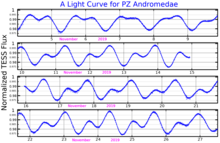63 Andromedae
| Observation data EpochJ2000EquinoxJ2000 | |
|---|---|
| Constellation | Andromeda |
| Right ascension | 02h20m58.202s[1] |
| Declination | +50° 09′ 05.39″[1] |
| Apparent magnitude(V) | 5.59[2] |
| Characteristics | |
| Spectral type | B9VpSi[3] |
| B−Vcolor index | −0.089[4] |
| Variable type | α2CVn[2] |
| Astrometry | |
| Radial velocity(Rv) | −0.30[5]km/s |
| Proper motion(μ) | RA:39.818[1]mas/yr Dec.:−31.607[1]mas/yr |
| Parallax(π) | 8.5275 ± 0.1684mas[1] |
| Distance | 382 ± 8ly (117 ± 2pc) |
| Absolute magnitude(MV) | +0.26[6] |
| Details[6] | |
| Mass | 3.07±0.14M☉ |
| Radius | 2.4±0.3R☉ |
| Luminosity | 110L☉ |
| Surface gravity(logg) | 4.29±0.11cgs |
| Temperature | 11,967K |
| Rotation | 4.189 days |
| Other designations | |
| Database references | |
| SIMBAD | data |
63 Andromedae(abbreviated63 And) is anAlpha2Canum Venaticorum (α2CVn) variablestarin theconstellationAndromeda.Itsvariable star designationisPZ Andromedae.With anapparent magnitudeof about 5.6, it is bright enough to be seen by naked eye. Based upon an annualparallax shiftof8.53mas,it is located 382light yearsaway.
The spectral type of this star is B9VpSi, indicating that it is a chemically peculiarmain sequencestar with abnormally strongsiliconlines. Although it has a B-type spectral class, this type of star is known as anAp star,a class of stars with very strong spectral lines of certain heavy elements and strong magnetic fields. The chemical peculiarities are caused by stratification in the atmosphere due to slow rotation.[7]
The star has 3 times themass of the Sunand 2.4 times theSun's radius.It is radiating 110 times theSun's luminosityfrom itsphotosphereat aneffective temperatureof 11,967 K.[6]

63 Andromedae varies in brightness by about 0.05 magnitudes with a period of 4.189 days. This is believed to occur as it rotates. This type ofvariable staris known as an α2Canum Venaticorum variable after the first example to be studied.[2]
To the naked eye the star figures as a faint, denseasterismwith 64 and 65 Andromedae (southwest and west), which together justify a rectangular projection (extreme) of the constellation (official boundaries).[9]North, west and east are an arm/hand, fictitiously and geometrically, of Perseus, whose character is related in traditional mythology as Andromeda's saviour, saving her from the sea monster, who forever retreats to beyondPisces,Cetus.The closest star in the asterisms commonly drawn up to represent the princess herself is51 Andromedae,to the east. At anapparent magnitudeof 3.57, this star shines two magnitudes or 6.3 times brighter.[9]
References
[edit]- ^abcdeVallenari, A.; et al. (Gaia collaboration) (2023)."GaiaData Release 3. Summary of the content and survey properties ".Astronomy and Astrophysics.674:A1.arXiv:2208.00211.Bibcode:2023A&A...674A...1G.doi:10.1051/0004-6361/202243940.S2CID244398875. Gaia DR3 record for this sourceatVizieR.
- ^abcSamus, N. N.; Durlevich, O. V.; et al. (2009). "VizieR Online Data Catalog: General Catalogue of Variable Stars (Samus+ 2007-2013)".VizieR On-line Data Catalog: B/GCVS. Originally Published in: 2009yCat....102025S.1:B/gcvs.Bibcode:2009yCat....102025S.
- ^Abt, H. A.; Morrell, N. I. (July 1995), "The Relation between Rotational Velocities and Spectral Peculiarities among A-Type Stars",Astrophysical Journal Supplement,99:135,Bibcode:1995ApJS...99..135A,doi:10.1086/192182.
- ^van Leeuwen, F. (2007)."Validation of the new Hipparcos reduction".Astronomy and Astrophysics.474(2): 653–664.arXiv:0708.1752.Bibcode:2007A&A...474..653V.doi:10.1051/0004-6361:20078357.S2CID18759600.Vizier catalog entry
- ^de Bruijne, J. H. J.; Eilers, A.-C. (October 2012), "Radial velocities for the HIPPARCOS-Gaia Hundred-Thousand-Proper-Motion project",Astronomy & Astrophysics,546:14,arXiv:1208.3048,Bibcode:2012A&A...546A..61D,doi:10.1051/0004-6361/201219219,S2CID59451347,A61.
- ^abcNorth, P. (June 1998), "Do SI stars undergo any rotational braking?",Astronomy and Astrophysics,334:181–187,arXiv:astro-ph/9802286,Bibcode:1998A&A...334..181N
- ^Renson, P.; Manfroid, J. (2009)."Catalogue of Ap, HgMn and Am stars".Astronomy and Astrophysics.498(3): 961.Bibcode:2009A&A...498..961R.doi:10.1051/0004-6361/200810788.
- ^"MAST: Barbara A. Mikulski Archive for Space Telescopes".Space Telescope Science Institute.Retrieved8 December2021.
- ^ab"Constellations.gif".RetrievedJuly 7,2022.

